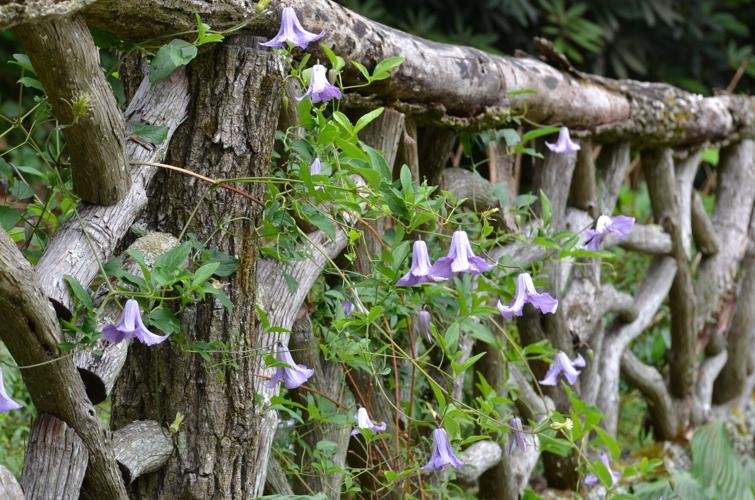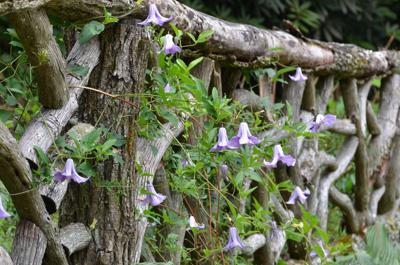Clematis, often called the “Queen of Climbers,” produces masses of flowers in a wide range of shapes and colors. Clematis plants can be trained to climb trellises, fences, arbors and obelisks, plus they can even scamper up trees. There are varieties today that are shorter and can be grown as a small shrub or in a container. With careful selection, you can enjoy blooms over a long season.
These lovely flowers come in a plethora of dazzling colors. You can find soft pastels like yellow, pink, lavender and blue or more dramatic colors like dark pink, bright red and deep burgundy. They come in white, too. Most of the flowers are quite large and showy, a trait that has been quite popular for years. I personally love the lavender-blue ones like Diana’s Delight, Jackmanii and HF Young.

Clematis plants can be trained to climb trellises, fences, arbors and obelisks.
In recent years, breeders and growers have developed small-flowered varieties that are vigorous and have a longer season of blooms. These are easy for me to maintain, since I know to cut them back in late winter without fear of pruning wrong. One of my favorites is Betty Corning, with bell-shaped flowers that are a pretty light blue. Princess Diana is another bell-shaped bloom that is pink.
When choosing the right clematis for a certain spot in your garden, it is very important to know the mature size of the plant. This will determine what type of support you will need. Some clematis grow to about 5 feet and can drape themselves over a bush in your garden, while others might grow to about 20 feet and be extremely heavy, requiring a sturdy support like a trellis or well-made fence. They can weave a rich tapestry of color and texture, making your garden even more glorious.
I grow Sweet Autumn clematis, and I have it going up a tree. This clematis can grow to about 20 feet — the vine goes up the tree and then weaves its way around several branches of the tree. In August, my black gum tree looks like it has white flowers on the lower limbs. My friends visiting assume that the tree is in flower.
When planting clematis, there is one rule I have heard over the years that you need to remember. Clematis like “their head in the sun and their feet in the shade.” Getting at least six hours of sun helps them have a profusion of blooms, and planting them by a bush or some structure that will shade the roots is ideal. If they get less sun than six hours, the plant will not be as healthy or bloom as much. Morning sun is ideal, as the hot afternoon sun can have a detrimental effect on clematis, especially in warmer climates. To shade the roots, a structure — a few large rocks or broken pieces of a clay pot around the base — will help shield them.

When choosing the right clematis for a certain spot in your garden, it is very important to know the mature size of the plant.
When planting clematis, plant them in fairly rich soil with some moisture, but not wet. If it gets dry in late summer, as it often does, give them a good drink of water. A light mulch helps to keep the roots cool, too, but do not go wild; just a light covering will do. Clematis also benefit from being given a little fertilizer in the spring. You can fertilize with a tomato fertilizer or a liquid fertilizer with a high middle number. A high nitrogen fertilizer will produce a lot of foliage with fewer blooms.
Dan Long, owner of Brushwood Nursery in Athens, Ga., is a clematis specialist. He has been specializing in growing and selling clematis for more than 20 years. Dan suggests planting most clematis level with the soil surface, but if you have Type 2, it is best to plant them a little deeper to protect the newly forming buds that are below ground level. However, if you are not sure, plant them at the same level.
Now, pruning is an issue that scares some people off. Pruning clematis can be put into one of three different groups or methods. You can remove dead or damaged stems at any time, but if you want to really know more about pruning, the tag will have instructions. They all have a number on them telling you which group your plant falls into. The main thing is to watch your plant and know when it blooms. Prune clematis when flowering is finished (this is true for so many flowering plants).
Group 1: These vines flower in spring on growth from the previous year. Prune these vines right after they finish blooming in spring. The new stems that grow will then have enough time to make flower buds for the following year.
Group 2: These vines bloom in late spring or early summer, then again sporadically, on new shoots and old stems. The vines that bloom mostly on older stems have their heaviest flush of flowers in late spring, while those that bloom mostly on new shoots are more prolific in the latter part of summer.
Group 3: These vines flower in late summer or in fall on new growth produced earlier in the season. These are the easiest vines to prune. Just before the season’s growth begins, or as it is beginning, lop all stems back to strong buds within a foot or so of the ground.
Think about growing a few of these wonderful vines that have lovely flowers and such a graceful habit. It might take a few years to get to the size you want, but these queens are well worth the wait.

Clematis like “their head in the sun and their feet in the shade."














